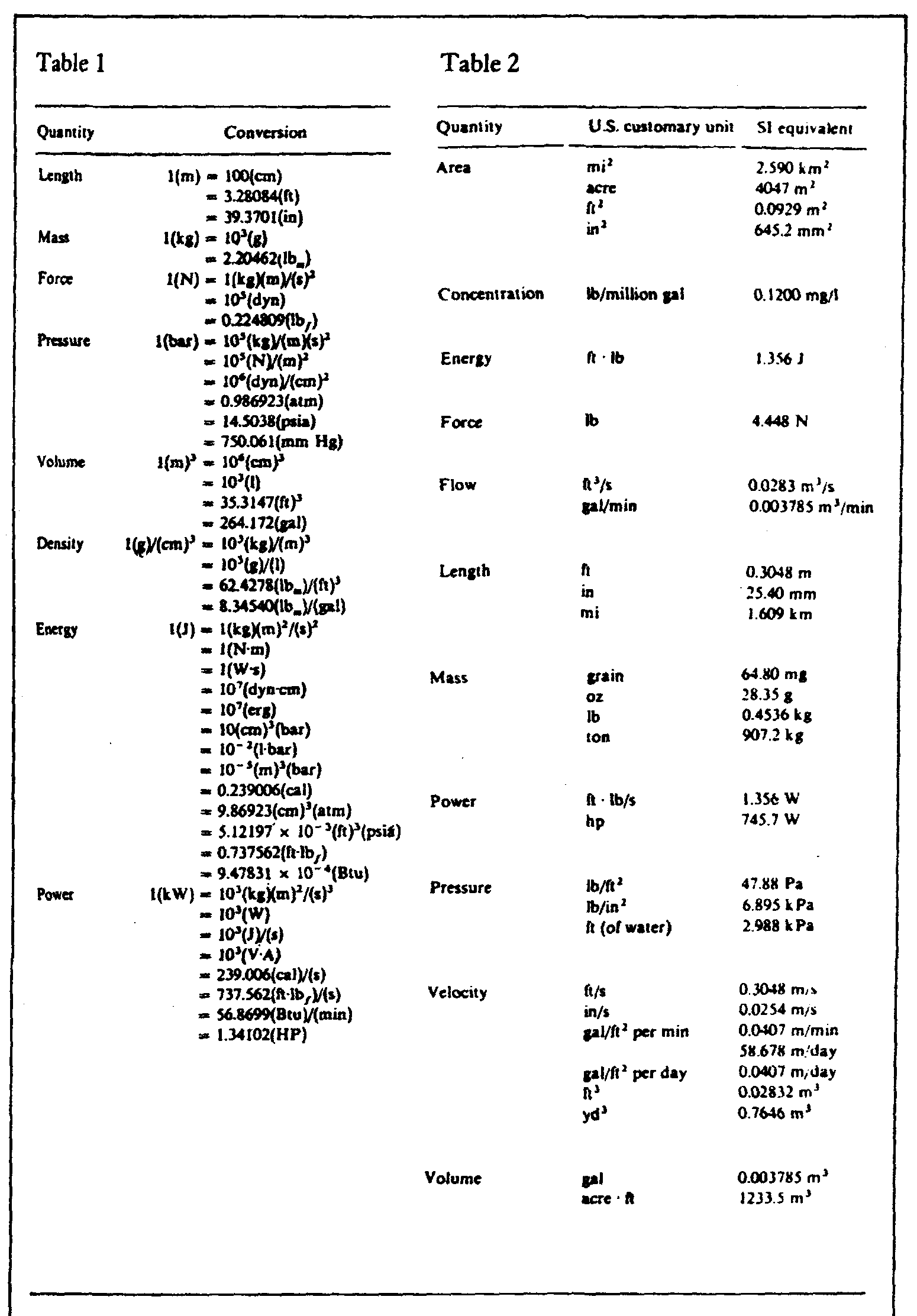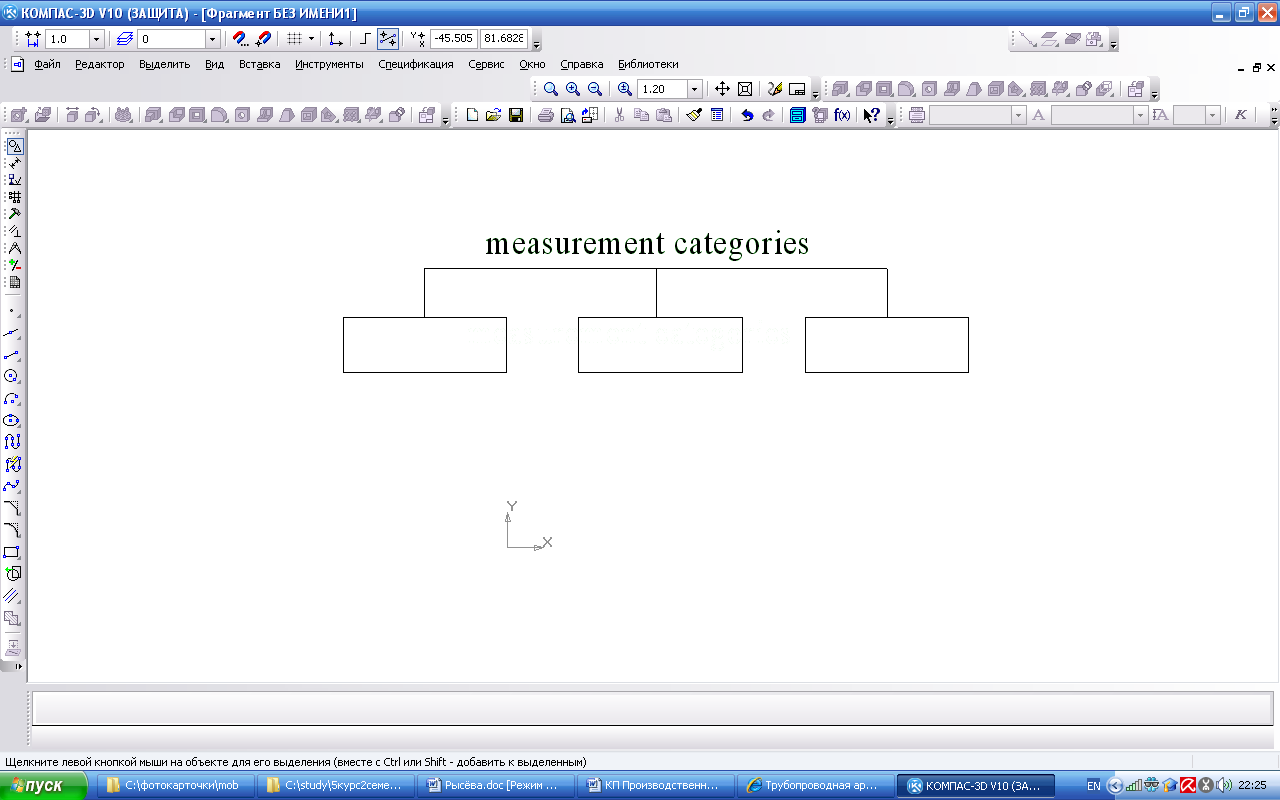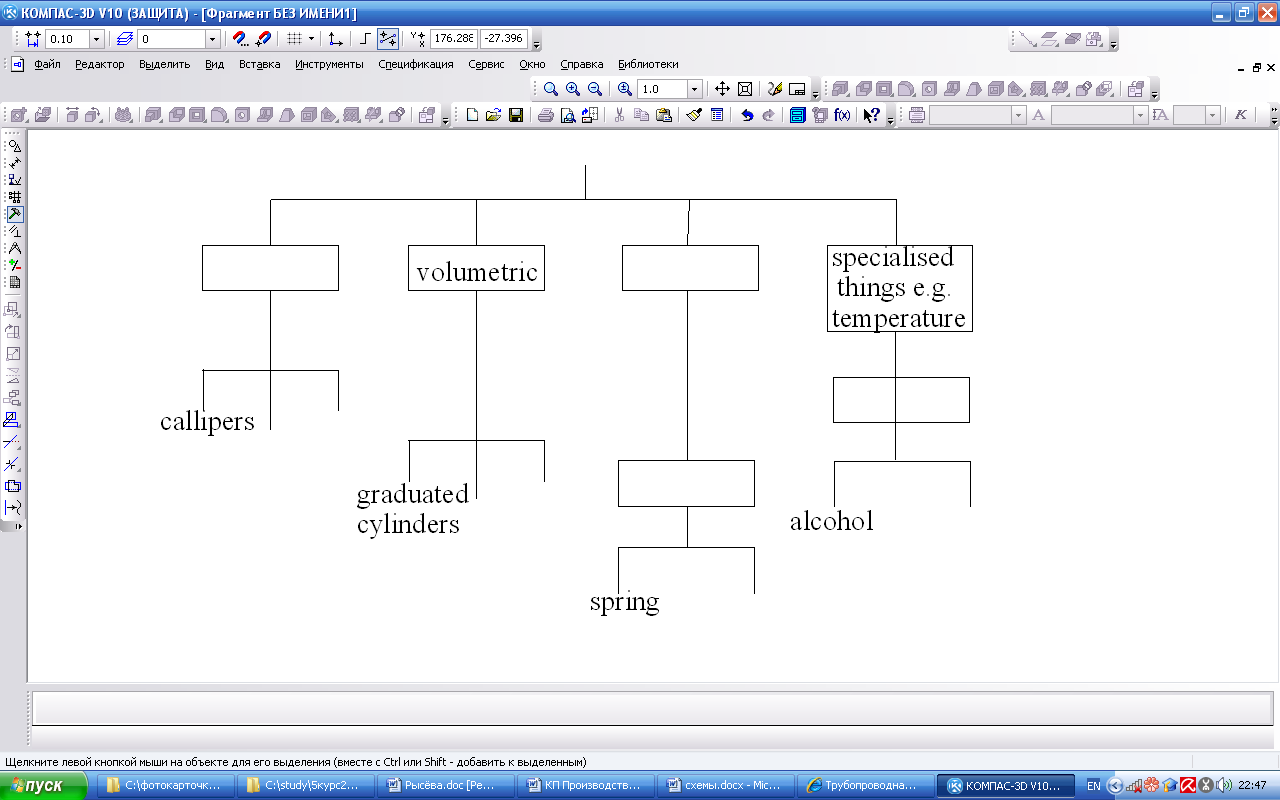
Unit 2
Measurement
Reading 1
This passage will introduce you to the principle of measurement in different fields of engineering. Look at the way it is divided into sections and paragraphs. Pay attention to the headings and to the table.
Task 1
Look at the questions and read the passage to find the answers. Remember, you do not have to understand every word.
1. Are engineering projects possible without knowledge of measurement?
2. How many types of temperature measurement are given in the third paragraph?
3. Do engineers need to know about all the different forms of measurement?
4. How many basic units is SI based on?
Measurement
Definition. A simple dictionary definition of the verb ‘to measure’ is: to find the size, quantity, volume, degree, weight, etc. of something by means of a standard or unit. In all branches of engineering, measurement plays a vital role since the design, manufacture and use of any product cannot be considered without reference to this concept. It is for this reason that the majority of texts on engineering contain tables, charts, lists or appendixes which provide the student with accepted standards and units of measurement.
Knowledge of measurement. We are all familiar with the symbols C and F for scales of temperature, but there is also K (Kelvin), which is the fraction (1/273.16) of the thermodynamic temperature of the triple part of water. Of course it may not always be necessary to understand the precise definition itself, provided one can understand the significance of the term or figure in relation to the diagram, chart or calculation involved. Each branch of engineering, naturally, tends to be more concerned with some particular forms of measurement than with others.
Conversion factors and SI equivalents. Look, for example, at Table 1 below, taken from a text for chemical engineers and which shows conversion factors. Then compare it with Table 2 which gives US customary units and their SI equivalents and comes from a text on sanitation engineering. At first glance it may seem difficult to find any connection between the two. However, if you look closely you will see that much of the information shown deals with the same things but from a different approach. Clearly, the students in either of the engineering branches would have little difficulty in using the figures and symbols relating to their own specialization.
SI Units. SI is the abbreviation for Systeme International d’Unites. SI is based on seven basic units, each of which is defined with great accuracy and from which all other basic units are derived. Under the system, each physical quantity has only one particular unit for its measurement. Thus, a length is only measured in metres. If the number employed with a basic unit is very small, or very large, then a prefix can be used as in km for kilometers. Conversion tables are necessary because the USA and Britain still retain a measurement system which is different from that used by the rest of the world.
Measuring devices. Since measurement is so important, it follows that there is a wide range of devices and instruments which are designed to indicate very precisely length, pressure, time and so on.
Task 2
Check your understanding
Read the text again carefully, looking up anything you don’t understand in a dictionary. Then answer the following questions:
1) What is measurement?
2) How many different symbols for measurement of length are shown in the two tables?
3) How is the US measurement of force different from the SI units?
4) Why do you think flow, concentration and velocity are in Table 2 but not in Table 1?
5) What is the principle on which SI is based?
6) What is the US customary unit for the SI equivalent 1.356J?
7) How many ‘ins’ are there in 1 ‘m’, according to Table 1?

Language study
Task 3
Look at the text and say what the following words refer to:
Paragraph 1: concept, reason
Paragraph 2: one
Paragraph 3: it, it
Paragraph 4: which, which
Paragraph 5: that
Task 4
Find the symbols in Tables 1 and 2 which match the words:
Joule |
|
|
kilogram |
|
Inch |
|
cubic metre |
|
|
Mile |
|
miles per second |
|
|
Watt |
|
pounds per square foot |
|
|
horse power |
|
milligrams per litre |
|
Word study
Task 5
Look at the first paragraph and say:
1) What words could you replace with ‘using’?
2) What word has the same meaning as ‘very important’?
3) What does ‘accepted’ mean here?
Task 6
Word Building
Fill in the following table:
Noun |
Verb |
design |
|
product |
|
significance |
|
calculation |
|
connection |
|
information |
|
specialization |
|
instructions |
|
Grammar study
Revise your grammar
Modals with Passive forms
Remember You should take care when using conversion chart. Care should be taken when using conversion chart.
You may use a prefix to express large numbers. Prefix may be used to express large numbers.
|
Task 7
Rewrite the following sentences using can / should / must / may with the passive form:
1) You must position the flywheel housing very precisely.
2) You can check the position by placing a magnetic base onto the crankshaft.
3) It is possible to convert miles into kilometers by multiplying by 1.609.
4) You can express the multiple 106 using the prefix ‘mega’ and you must use M as the symbol for this.
5) With SI numbers, you should not use a comma to separate multiples of a thousand. You may use a space instead.
Reading 2
Task 8
Read the text and think of Russian equivalents to the words in bold.
Measurable parameters
Supply, demand and capacity
Calculating the capacity of an electricity grid - the amount of energy it needs to supply to users - might seem simple. Just add up the power supplied over a given period of time to give the total amount consumed by users. Then, divide the cumulative amount of power used during the whole period by the number of hours in the period. The result is an average level of consumption per hour. But there's one problem with this method - and it's a major one.
 The
rate
of
power consumption - the amount that's being consumed at a particular
moment - is not constant.
In
other words, consumption does not stay at the same level all the
time. So electricity supply
requirements
cannot simply be averaged
out over
time. People use more power at certain times of day, and less at
other times, which means that demand
for
power fluctuates
significantly.
Generally, it rises to a maximum in the evening (peak
demand
is at evening mealtimes), and falls to its lowest levels during the
night. These fluctuations
are
so big that at peak
times consumption
can be twice as high as it is during off-peak
times. Clearly,
the grid needs to have sufficient capacity to meet
demand when
consumption peaks.
But
since each peak is brief, the grid will only run
to capacity -
at or close to its maximum capability - for a few moments each day.
This means, most of the time, it has significant spare
capacity.
The
rate
of
power consumption - the amount that's being consumed at a particular
moment - is not constant.
In
other words, consumption does not stay at the same level all the
time. So electricity supply
requirements
cannot simply be averaged
out over
time. People use more power at certain times of day, and less at
other times, which means that demand
for
power fluctuates
significantly.
Generally, it rises to a maximum in the evening (peak
demand
is at evening mealtimes), and falls to its lowest levels during the
night. These fluctuations
are
so big that at peak
times consumption
can be twice as high as it is during off-peak
times. Clearly,
the grid needs to have sufficient capacity to meet
demand when
consumption peaks.
But
since each peak is brief, the grid will only run
to capacity -
at or close to its maximum capability - for a few moments each day.
This means, most of the time, it has significant spare
capacity.
Input, output and efficiency
Power lines and transformers are relatively inefficient, wasting energy - mainly by giving off heat. As a result, there is a difference between input - the amount of energy put into the grid by power stations, and output - the amount used by consumers. On a typical grid, the difference between input and output is about 7% - there is a 7% energy loss. But if electricity is generated at the place where it's consumed, and not transmitted through long-distance power lines, this loss can be avoided. Consequently, locally produced electricity is more efficient than grid-supplied power, as there is a gain in efficiency of around 7%.
One way to produce power locally is with photovoltaics (PVs) - often called solar panels. However, many PV installations are still connected to the electricity grid. This means that when there is surplus power - when electricity is being produced by the solar panels faster than it is needed in the home - it is fed into the grid. If consumption exceeds production - if electricity is being used in the home faster than the solar panels can produce it - then power is taken from the grid. Homes with low consumption may therefore become net producers of power, producing more electricity than they consume.
Vocabulary
Task 9
An engineer is talking to a colleague about the design of a fuel tank for a water pump. Complete the explanation using the words in the box.
average constant consumption duration capacity consume cumulative rate |
Fuel (1) __________ for this engine is about 1.5 litres per hour. Of course, sometimes it’ll (2) __________ a bit more, sometimes a bit less, depending on the workload. But 1.5 is an (3) __________ figure. And let’s say the (4) __________ of a work shift is 8 hours. The pump will have to be stopped occasionally, to clean the intake filter, so it won’t be 8 hours of (5) __________ running. But we’ll say 8 hours, to be on the safe side. So 8 hours of running at a (6) __________ of 1.5 litres per hour gives 12 litres of (7) __________ consumption over a shift. So if we want the pump to have sufficient fuel autonomy for an 8-hour shift, the (8) __________ of the fuel tank needs to be 12 litres, minimum.
Task 10
Choose the correct words from the brackets to complete the explanations from a guided tour of a manufacturing plant.
1. A lot of heat is generated in this part of the process. And all of that (input / output) is recycled - it provides a (demand / supply) of heat for the next stage of the process. So it's quite an (efficient / inefficient) system.
2. Sometimes, there's (insufficient / surplus) heat, and it can't all be recycled. At other times there isn't quite enough recycled heat to keep up with (peak / off-peak) demand for heat energy further along the process.
3. Some material is lost in the washing process, but the mass of water absorbed is greater than the mass of material lost. So there's a net (loss / gain) in total mass.
Listening
Task 11
You will hear a part of a lecture. It has been divided into sections to enable you to understand it more easily. After each section answer the following questions.
Section 1.
1) Is this the first lecture the speaker has given to the class? If not, how do you know?
2) What is the subject of this lecture?
3) Does the lecturer specify an exact number of ways to classify measuring devices?
Section 2.
Complete the classification diagram below with the three categories mentioned by the lecturer.

Section 3.
Complete the top section of the classification diagram below.

Section 4.
Complete as much of the rest of the diagram as possible with the examples of measuring devices mentioned in this section of the lecture.
Section 5.
How does the household thermometer function, according to the lecturer?
Speaking practice
Task 12
Give a short talk on measuring devices and how they can be classified. You should refer to the diagrams as you talk. Then choose one measuring device and write a brief explanation about the way it can be classified.
Grammar database
1,000 — a / one thousand
8,000 — eight thousand
200,000 — two hundred thousand
1,000,000 — a / one million
6,000,000 — six million
121 — one hundred and twenty one (books)
7,006 — seven thousand and six
3,200 — three thousand and hundred
2,045,328 — two million forty-five thousand three hundred and twenty eight
1/2 — a half
1/3 — a / one third
3/4 — three quarters
2/9 — two ninths
3 — three seventh
7
23 — twenty three over fifty six
56
0.25 — zero / nought point two five
2.456 — two point four five six
7.089 — seven point o[ou] eight nine
0.7 — point seven
0.06 — ou point ou six
5² — five squared (five in the second power)
5 3 — five cubed (five to the third power)
в n-ной степени — in the nth power
Tapescript
You will now hear part of a lecture. It is divided into sections to make it easier for you to follow.
Now, as you will remember from my last lecture, measurement is a very important element in all engineering studies. We have already talked about some of the reasons for that, and later in this lecture I intend to go into more detail about the types of calculation involved in measuring pressure. However, to begin, I want to give you a little information about some of the ways in which we can group or, more correctly, classify measuring devices. Now, what exactly are these devices?
A measuring device is a mechanism designed to find the dimensions, capacity, or amount of something. Measuring devices can be divided into groups in several ways. For example, they can be divided according to the nature of the things they are designed to measure; or they can be divided according to the type of measuring unit each device uses, or in any number of other ways.
If they are grouped according to the nature of things they are designed to measure, we might have some devices for measuring ground-up solids (such as flour, gravel, chemicals in powdered form etc.) and some for measuring things requiring linear measurement (such as measurement for dimensions). Many other possible types of things and their devices could be included: the three are mentioned only as a sample.
If we group measuring devices according to the type of measuring unit each uses, we might have the following types: linear units (feet, centimeters, inches, miles, metres etc.), volumetric units (litres, ounces etc.), weight units (grams, ounces, pounds etc.), and the units used for more specialized things such as electric current and temperature (amps, degrees centigrade etc.).
Some examples of devices that use different types of measuring units are rules, callipers and measuring tapes — all of which measure linear dimensions; balances — the most common being spring and beam balances - for measuring weight; and containers such as graduated glass cylinders found in chemistry laboratories, and the measuring cups and measuring spoons found in kitchens — all used for measuring volume.
A common example of a measuring instrument (device) used to measure more specialised things is the thermometer, which measures temperature. Typical household thermometers are those containing either alcohol or mercury. These instruments measure temperature quite differently from the way a rule measures linear dimensions, for example. The rule measures directly; the thermometer actually measures the expansion or contraction of the liquid inside it, and this is shown on a scale that is marked in units representing temperatures.
